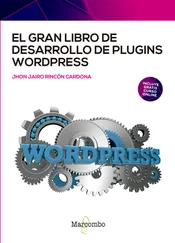1 v PROFESSIONAL WORDPRESS ® PLUGIN DEVELOPMENT Second Edition Brad Williams Justin Tadlock John James Jacoby
2 xxix FOREWORD This book will teach you how to develop for WordPress. WordPress has, over the past two decades, grown into the CMS that powers more than one‐third of all websites. If you're proficient at WordPress development, you'll never be out of a job again. Starting out as a simple blogging system, over the last few years WordPress has morphed into a fully featured and widely used content management system. It offers individuals and companies worldwide a free and open source alternative to closed source and often very expensive systems. When I say fully featured, that's really only true because of the ability to add any functionality needed in the form of a plugin. The core of WordPress is simple: you add in functionality with plugins as you need it. Developing plugins allows you to stand on the shoulders of a giant: you can showcase your specific area of expertise and help users benefit while not having to deal with parts of WordPress you don't care or know about. When I wrote the foreword of this book's first edition, nine years ago, I'd just started my own company. That company has since grown to consist of 100+ people, and our plugins are used on more than 10 million sites—all through the power of open source and plugins. I wished that when I started developing plugins for WordPress as a hobby, almost 15 years back, this book had been around. I used it as a reference countless times since, and I still regularly hand this book to new colleagues. The authors of this book have always been a source of good information and wonderful forces in the WordPress community. Each of them is an expert in his own right; together they are one of the best teams that could have been gathered to write this book, and I'm glad they're here for a second edition. WordPress makes it easy for people to have their say through words, sound, and visuals. For those who write code, WordPress allows you to express yourself in code. And it's simple. Anyone can write a WordPress plugin. With this guide in hand, you can write a plugin that is true to WordPress’ original vision: code is poetry. Happy coding! Joost de Valk Yoast.com
3 xxxi INTRODUCTION Dear reader, thank you for picking up this book! You have probably heard about WordPress already, the most popular self‐hosted content management system (CMS) and blogging software in use today. WordPress powers literally millions of websites on the Internet, including high‐profile sites such as TechCrunch and multiple Microsoft websites. What makes WordPress so popular is that it's free, open source, and extendable beyond limits. Thanks to a powerful, architecturally sound, and easy‐to‐use plugin system, you can customize how WordPress works and extend its functionalities. There are already more than 55,000 plugins freely available in the official plugin repository, but they won't suit all your needs or client requests. That's where this book comes in handy! As of this writing, we (Brad, Justin, and John) have publicly released more than 100 plugins, which have been downloaded millions of times, and that's not counting private client work. This is a precious combined experience that we are going to leverage to teach you how to code your own plugins for WordPress by taking a hands‐on approach with practical examples and real‐life situations you will encounter with your clients. The primary reason we wanted to write this book is to create a preeminent resource for WordPress plugin developers. When creating plugins for WordPress, it can be a challenge to find the resources needed in a single place. Many of the online tutorials and guides are outdated and recommend incorrect methods for plugin development. This book is one of the most extensive collections of plugin development information to date and should be considered required reading for anyone wanting to explore WordPress plugin development from the ground up.
4 xxxii Simply put, this book is for anyone who wants to extend the way WordPress works, whether it is for fun or profit.
5 xxxiii To help you get the most from the text and keep track of what's happening, we've used a number of conventions throughout the book. WARNING Boxes with a warning label like this one hold important, not‐to‐be‐forgotten information that is directly relevant to the surrounding text. NOTE The note label indicates notes, tips, hints, tricks, and asides to the current discussion. As for styles in the text: We italicize new terms and important words when we introduce them. We show keyboard strokes like this: Ctrl+A. We show filenames, URLs, and code within the text like so: persistence.properties. We present code in two different ways: We use a monofont type with no highlighting for most code examples. We use bold to emphasize code that is particularly important in the present context or to show changes from a previous code snippet.
6 xxxiv To find the errata page for this book, go to www.wiley.com and locate the title using the Search box. Then, on the book details page, click the Errata link. On this page, you can view all errata that have been submitted for this book and posted by editors. If you don't spot “your” error on the Errata page, go to support.wiley.com and follow the directions to contact technical support and open a ticket to submit the error. We'll check the information and, if appropriate, post a message to the book's errata page and fix the problem in subsequent printings of the book.
7 1 1 An Introduction to Plugins WHAT'S IN THIS CHAPTER? Understanding what a plugin is Using available WordPress APIs Finding examples of popular plugins Separating plugin and theme functionality Managing and installing plugins Understanding types of WordPress plugins WordPress is the most popular open source content management system available today. One of the primary reasons WordPress is so popular is the ease with which you can customize and extend WordPress through plugins. WordPress has an amazing framework in place that gives plugin developers the tools needed to extend WordPress in any way imaginable. Understanding how plugins work, and the tools available in WordPress, is critical knowledge when developing professional WordPress plugins.
8 2
9 3
10 4
11 5 As you can see, the preceding plugins can handle a variety of complex tasks. The features added by these plugins are universal and features that many websites on the Internet could have.
12 6 Another advantage to building plugins is the structure that already exists for your plugin. Many of the common features have already been developed and are ready for use in your plugin. For example, you can take advantage of the built‐in user roles in WordPress. Using the user roles, you can easily restrict your code to execute only if a user is an administrator. Look at this example: As you can see, it's easy to verify that a user has proper permissions prior to executing any code in your plugin. You will learn about user accounts and roles in Chapter 9 , “Users and User Data.” As another example, look at sending an email in WordPress. Sure, you could create a new function in your plugin to send email, but why? WordPress has a handy function called wp_mail() for sending email. Look at this example: As you can see, sending an email in WordPress couldn't be easier. Unless your plugin needs some customized emailing functionality, you don't need to re‐create this function from scratch. Using this function also ensures the widest adoption for sending emails from WordPress because you use the built‐in function. Using the available built‐in features of WordPress can greatly reduce the time to develop a plugin. Another advantage of not reinventing the wheel is that this approach more often than not will allow for your plugins to work across a greater number of servers and setups, thereby maximizing compatibility. Don't reinvent the wheel with features that already exist in WordPress.
Читать дальше












